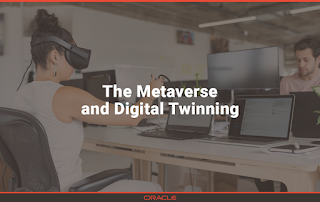As 2022 is expected to be the year where the groundwork for the metaverse for the next decade, at least more tools are being utilized to accelerate metaverse adoption. The digital twin is one such tool that encapsulates and actuates the capabilities of the metaverse.
A term coined by the National Aeronautics and Space Administration (NASA), digital twins are digital copies of physical objects; virtual representations that replicate these objects or processes in real-time. These twins are updated from the real-time data they collect and use simulation, as well as machine learning, to perfect decision-making. Digital twinning has several use cases. Healthcare professionals simulate rare illnesses and learn the correct techniques to care for these illnesses. At the same time, environmentalists use digital twinning to simulate different climate change extremes based on oceans and rainforests.
Digital twins are becoming increasingly popular thanks to the increased advent of augmented and virtual reality. As they garner more of a mainstream presence, digital twins highlight how the metaverse aids industries and presents opportunities for digital twins to create the metaverse.
How Digital Twins are Essential Facets for the Metaverse
https://images.unsplash.com/photo-1633151188217-7c4c512f7a76?ixlib=rb-1.2.1&ixid=MnwxMjA3fDB8MHxwaG90by1wYWdlfHx8fGVufDB8fHx8&auto=format&fit=crop&w=1074&q=80
Digital twinning brings the Metaverse to light
Digital twins feature sensors that relay information and strengthen Internet of Things (IoT) object connections. Through the synchronization of physical and virtual worlds, real-world changes are reflected in the digital twin, with feedback being sent the other way.
Digital twins are essential building blocks for the metaverse because they add greater visual representations and enhancements to add greater realism to the metaverse. The metaverse offers virtual experiences and worlds that are supposed to transform imaginations and create new opportunities for all who interact. However, with digital twinning, the metaverse will have precise replications of reality, creating more use cases for industries, both for B2B and B2C businesses.
Within professional settings, meetings occurring in the metaverse become more productive because participants consistently interact with exact replicas of a company’s information system and equipment. Or, for technical training programs, technicians can further use applications to create 3D representations of layered systems. Complete maintenance workshops can be recreated within the metaverse, with digital twins of machines and tools requiring servicing, with potential connectivity to real workshops to ensure that maintenance is conducted remotely.
Simplifying the Virtual World and Providing New Possibilities

https://images.pexels.com/photos/834949/pexels-photo-834949.jpeg?auto=compress&cs=tinysrgb&dpr=2&h=650&w=940
Digital twinning opens up endless possibilities in the metaverse
The virtual world can be intimidating for some, considering how visually intricate and surreal it can be. However, digital twins simplify the presentation of the metaverse, providing more realism and ease of use with virtual representations of real-life spaces.
By creating 3D realized locations of notable buildings, you provide new opportunities for people who can’t physically travel to visit these spaces, whether due to financial or geographical constraints. Such buildings and the people who operate them can be examined in a new light. Digital visitors in the metaverse can also view everything about a business, including its architecture and business management, thanks to digital twins filled with sensor data, providing a wide range of information. Whole buildings are constructed and filled through digital tools, creating remote training opportunities. Businesses realize fewer losses, and users can be assured of complete safety, meaning that anything can be tried within the metaverse.
The fusion of virtual and physical spaces increases the possibility for monitoring, simulation, optimization, and prediction. Digital twins can also transform learning and development, mirroring business processes and fostering leadership traits through mirroring resilience profiles, growth mindsets, competency models, and learning styles.
Digital Twins Will Also Eradicate Misconceptions Within the Metaverse
The metaverse will become the ideal environment for digital twins to congregate and develop, with more use cases expected to play out in 2022.
Digital twins not only simplify the presentation of the virtual world but clear up misconceptions often associated with the metaverse. One such misconception is that virtual scanned objects found within the metaverse are digital twins. Scanned objects, in truth, are facades of digital twins but don’t become digital twins until they are incorporated with real-time data feeds and metadata from sensors that are simultaneously overlaid.
The global market for digital twins is valued at just over $7.5 billion, with expected growth to top $46 billion by 2026. The reason for market growth is that digital twins are expected to fulfill their promise within the metaverse. Digital twins will still carry out mundane tasks like being an asset management environment to store, access, and visualize equipment performance data. However, there will be more possibilities to carry out these tasks at scale, with greater storage and data management capabilities, with more businesses managing digital twin inventories over a defined period.
Digital twinning will be a leading aspect of the metaverse, transforming operational approaches for various industries while allowing people to explore possibilities that financial and location-based complications prevent them from enjoying. The metaverse is a real thing, and digital twinning adds realism to increase the metaverse’s widespread adoption.





Comments
Post a Comment